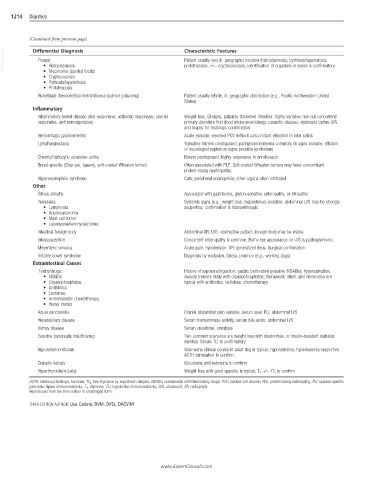Page 2452 - Cote clinical veterinary advisor dogs and cats 4th
P. 2452
1214 Diarrhea
(Continued from previous page)
VetBooks.ir Differential Diagnosis Characteristic Features
Fungal:
Patient usually very ill; geographic location (histoplasmosis, pythiosis/lagenidiosis,
• Histoplasmosis
protothecosis, +/− cryptococcosis), identification of organism in lesion is confirmatory
• Mycotoxins (spoiled foods)
• Cryptococcosis
• Pythiosis/lagenidiosis
• Protothecosis
Rickettsial: Neorickettsia helminthoeca (salmon poisoning) Patient usually febrile, ill; geographic distribution (e.g., Pacific northwestern United
States)
Inflammatory
Inflammatory bowel disease (diet responsive, antibiotic responsive, steroid Weight loss, GI signs, palpably thickened intestine: highly variable; rule out concurrent/
responsive, and nonresponsive) primary disorders first (food intolerance/allergy, parasitic disease, dysbiosis) before U/S
and biopsy for histologic confirmation
Hemorrhagic gastroenteritis Acute episode; elevated PCV without concomitant elevation in total solids
Lymphangiectasia Yorkshire terriers predisposed; panhypoproteinemia common; GI signs variable; effusion
or neurologic/respiratory signs possible (embolism)
Chronic/histiocytic ulcerative colitis Boxers predisposed; highly responsive to enrofloxacin
Breed-specific (Shar-pei, basenji, soft-coated Wheaten terrier) Often associated with PLE. Soft-coated Wheaten terriers may have concomitant
protein-losing nephropathy.
Hypereosinophilic syndrome Cats; peripheral eosinophilia, other organs often infiltrated
Other
Villous atrophy Associated with gastrinoma, gluten-sensitive enteropathy, or idiopathic
Neoplasia: Systemic signs (e.g., weight loss, inappetence) possible; abdominal U/S may be strongly
• Lymphoma supportive; confirmation is histopathologic.
• Adenocarcinoma
• Mast cell tumor
• Leiomyoma/leiomyosarcoma
Intestinal foreign body Abdominal XR, U/S: obstructive pattern, foreign body may be visible.
Intussusception Concurrent enteropathy is common. Bull’s-eye appearance on U/S is pathognomonic.
Mesenteric volvulus Acute pain, hypotension. XR: generalized ileus. Surgical confirmation.
Irritable bowel syndrome Diagnosis by exclusion. Stress common (e.g., working dogs).
Extraintestinal Causes
Toxins/drugs: History of exposure/ingestion; gastric perforation possible (NSAIDs); hypersalivation,
• NSAIDs muscle tremors likely with organophosphates; therapeutic intent and intolerance are
• Organophosphates typical with antibiotics, lactulose, chemotherapy
• Antibiotics
• Lactulose
• Antineoplastic chemotherapy
• Heavy metals
Acute pancreatitis Cranial abdominal pain variable; serum spec PLI, abdominal U/S
Hepatobiliary disease Serum transaminase activity, serum bile acids, abdominal U/S
Kidney disease Serum creatinine, urinalysis
Exocrine pancreatic insufficiency Two common scenarios are weight loss with steatorrhea, or insulin-resistant diabetes
mellitus. Serum TLI is confirmatory.
Hypoadrenocorticism Wax-wane clinical course in adult dog is typical; hyponatremia, hyperkalemia supportive;
ACTH stimulation to confirm
Diabetic ketosis Glucosuria and ketonuria to confirm
Hyperthyroidism (cats) Weight loss with good appetite is typical; T 4 +/− fT 4 to confirm
ACTH, Adrenocorticotropic hormone; fT 4 , free thyroxine by equilibrium dialysis; NSAIDs, nonsteroidal antiinflammatory drugs; PCV, packed cell volume; PLE, protein-losing enteropathy; PLI, species-specific
pancreatic lipase immunoreactivity; T 4 , thyroxine; TLI, trypsin-like immunoreactivity; U/S, ultrasound; XR, radiograph.
Reproduced from the third edition in unabridged form.
THIRD EDITION AUTHOR: Lisa Carioto, DVM, DVSc, DACVIM
www.ExpertConsult.com

